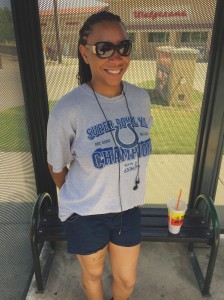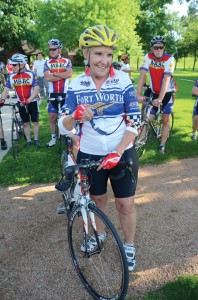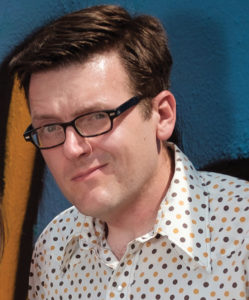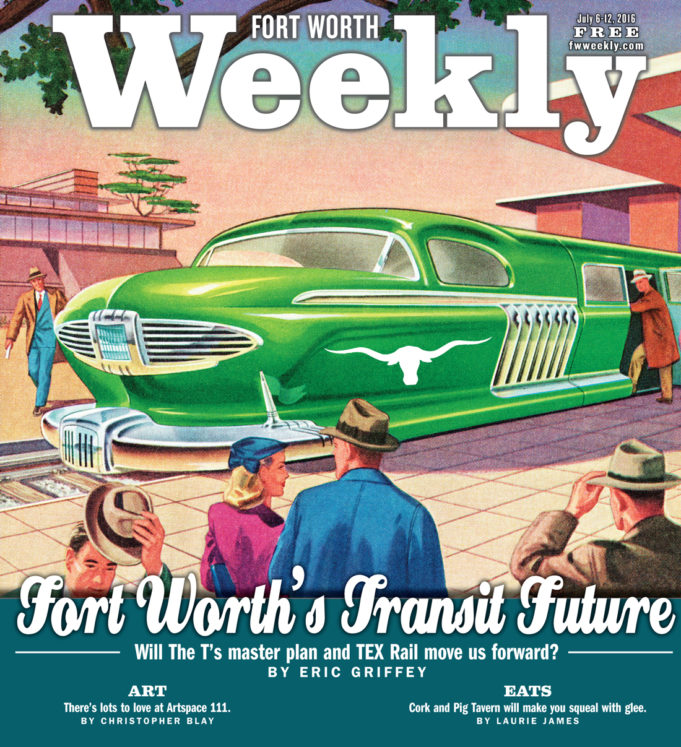On an oven-hot Sunday in July, the No. 25 bus pulled up to its stop at the intersection of Hulen Street and Camp Bowie Boulevard. The five of us waiting there stirred. We had been huddled beneath what little shade was cast by the small canopy (called a bus shelter) that stood next to a bench that was too hot to sit on. The bus doors opened, and its driver walked out and into the nearby Walgreens without saying a word to us. Apparently the bus was ahead of schedule, and we were going to have to wait.
“He’ll be back,” mocked Marcus Clark, a man in his 40s. “He’s not going to leave you.” He lit up a cigarette moments after telling me a story about a friend who has emphysema.
Clark has been using the bus every day “for years,” he said. It’s his main source of transportation.
“If I had one complaint, it’s that they are too slow on Sundays,” he said. “They need to improve that.”
Chardrae Campbell has been riding the bus to get to and from work since finishing high school eight years ago, she said. She agreed with Clark about Sundays, but that was the extent of her complaints about the Fort Worth Transportation Authority, also known as The T.
“It’s pretty much been the same this whole time,” she said.

Eventually, the driver returned to his seat, again without saying a word, and the four other riders and I boarded. As it turns out, I wanted the No. 2 bus, which wasn’t going to arrive for another hour. (Buses traverse Camp Bowie Boulevard every 15 minutes on weekdays.) Nearly an hour later, I jumped on my chariot and was whisked away to the Cultural District, where, after a 10-minute soaking hot walk, I made it to the Fort Worth Weekly offices.
The T is trying to entice people like me to ride: young (-ish, in my case) professionals who have cars but would rather not fight traffic to get to work. And The T is making that case with more urgency than ever before.
Established in 1983 to oversee public transportation in Fort Worth, The T is partially funded by tax dollars from three cities: Fort Worth, Richland Hills, and Blue Mound. Most of the agency’s operation involves managing 225 buses and 36 routes within its service areas. The agency also partners with Dallas Area Rapid Transit (DART) to operate the Trinity Railway Express (TRE), a commuter rail service that runs to Dallas and back with multiple stops along the way. In ’83, Fort Worth voted to dedicate a half-cent of sales tax to fund the agency.
Over the past few years, The T and city, state, and federal officials have prioritized getting cars off the road. Through myriad grants, development programs, and construction projects, the transportation and transit landscape in Fort Worth is on the verge of looking completely different –– and a lot of the agencies’ new sense of urgency is a reaction to the coming TEX Rail, a 27-mile commuter train that will connect Fort Worth to Dallas/Fort Worth International Airport.
Fort Worth and Tarrant County are expanding like Jiffy Pop, with more than 36,000 people relocating to within our county lines over the last 12 months, according to U.S. Census data. We’re already the 16th largest city in the country, and projections by the Texas Water Development Board indicate that Cowtown’s headcount will approach 1.5 million by 2040 –– a population surge of nearly 84 percent from 2014.
As government officials scramble to accommodate all of the Fort’s new folks, the looming question is how to get people from point A to point B in such a rapidly changing environment. It’s a like a demographic puzzle with pieces that are constantly changing shape.
For years, and particularly since Betsy Price was elected mayor in 2011, City Hall has encouraged a people-friendly brand of urban development. Areas like the Near Southside, Downtown, and West 7th have, to varying degrees, become more walkable and bike-friendly than they were 10 years ago. The city is covered in orange construction cones as roads are being built around the apartments, luxury condos, and different developments that are popping up around town at the pace of the Game of Thrones intro.

Transportation and transit challenges lurk in every corridor of the city: the permanent Frogger game that is West 7th; modernizing roads in the sprawling northern areas of town; implementing progressive neighborhood designs to poor areas; dealing with the traffic congestion caused by construction; finding funding for all of the starry ideas in the various government plans.
Earlier this year, The T unveiled its new master plan. This was around the same time the city released its master thoroughfare plan. Both encourage people to use public transit in a city that hasn’t exactly embraced the idea of hopping on a bus or a train –– and that’s not a coincidence.
Of the five largest cities in Texas, Fort Worth gets the least amount of annual funding for transit, according to 2014 tax data. The T received $61 million to serve a population of more than 825,000. San Antonio, which served 1.8 million people that year, received $159 million –– roughly 61 percent more. Houston, which spends the most money on transit in the state, had $672 million for a population of 3.7 million. That’s 91 percent more in funds.
There’s a palpable rush to get ready for the impact of TEX Rail. Fort Worth officials believe the line is necessary to compete with Dallas for tourism dollars coming from the airport. Last week, that project cleared a major hurdle when The T and the other planners received a letter of no prejudice from the Federal Transit Administration. The letter is assurance that, even though the federal agency hasn’t yet given the project full funding, local authorities will be reimbursed for any money spent.
TEX Rail has its share of critics. The train is projected to serve more than 8,000 daily riders by the end of the first year of service and more than 13,600 by 2035. But one of the more controversial parts of the line is how it’s being funded. At the moment, the project is only halfway to its $1 billion goal. The feds have pledged enough money to finish construction, but with our country’s political future so uncertain, many critics of TEX Rail see the project as a potential tax boondoggle.
Chief among the project’s detractors is Republican State Sen. Konni Burton from Colleyville. She and others worry that local tax payers will have to shoulder the burden for a project that Burton and company feel not enough people want.
A lot of the future of Fort Worth’s public transportation needs hinges on The T, which has plenty of detractors, who say its reputation for being slow to add bus lines in growing areas doesn’t inspire confidence in the big ideas of its master plan. Despite the fact that The T has had a lot of turnover on its board and only two years ago hired a new president, Paul Ballard, many are still skeptical that the organization can lead us into a new-look transit world.
Kevin Buchanan, who pens the Fort Worthology urban development blog for the Fort Worth Weekly and has been writing about urban development for more than a decade, is skeptical that any part of The T’s master plan will be implemented in a timely fashion.
“There’s a lot of good stuff in the master plan,” he said. “That’s encouraging. My problem with it is that their track record doesn’t give me much confidence. It took forever for there to be more stops on 7th Street after all of the residents started moving in over there.”

He and others are still reeling from what they feel is a missed opportunity when the Fort Worth City Council pulled the plug on a streetcar project while it was still in the early phases.
Mayor Price said she’s optimistic that, with enough support from the city, people will eventually come around to public transit.
“We’re never going to pour enough concrete to accommodate all of the cars and buses we’ll need,” she said. “So it’s really about reeducation … and making plans to increase public transit and making it easier and more affordable for people to use.”
******













The public transportation in Tarrant county is so lacking. I live between 820 and 287, work just south of 20. I’ve battled 35 for 15 years. I come into work an hour early to avoid the traffic. Most days I get off 35 at 30 to avoid the constant congestion between I30 and I820. As the new toll roads between 360 and 820 have shown, the new toll lanes will not improve traffic for the majority of people, just those willing to pay the toll. Then we all suffer when the toll lanes disappear and everyone is forced back to the original road.
I can’t use public transportation to get 17 miles up and down one of the major highways in this city. I don’t understand how such a large city has such a lacking public transportation system.
I applaud the city and the mayor that FW wants to develop a more walkable city. But I think this article addresses 3 different things.
First, the “Frogger” game on 7th street, which can easily be solved in 2 words: pedestrian bridges. We have them in several areas of high traffic in the city and surrounding areas.
Second, the bus system, which is a bigger problem. My SO takes the bus to work each day; he has to leave the house at 6 am and take 3 different buses to get to work while I leave at 7:15 am and it takes me 11 minutes to drive from driveway to parking spot. I’ll never take a a bus when it takes an hour and 15 minutes longer to get to the same place. (We work together.) So, the city can add more buses, it can start using the interstates for express buses, or I just don’t see buses as the only answer.
Finally, overall traffic and congestion in general. Fort Worth is not an island unto itself. It is a world class destination for people all over the state and the country. It has exquisite dining, cultural events, museums, nature, and experiences no one can get anywhere else – Bass Hall, the Botanical Gardens, Amon Carter, Kimbell and Modern, the stockyards, the Stock Show and Rodeo, Tim Love’s and John Bonnell’s restaurants among many others. No one, and I mean no one is dressing in their finest, hopping on their bicycles and peddling down the interstate from Keller or Weatherford, or Granbury, or Brock/Peaster/Aledo/Azle/Mineral Wells/Justin/Roanoke or anywhere else to eat dinner at Waters or Eddie V’s. No one is strapping their small children into their helmets to peddle down I35 or I30 or I20 to come to to the FW Science and History Museum on a Saturday afternoon. The real issue is creating a light rail system to connect all these towns (As DART connects Dallas,Irving, Mesquite, Carrollton, and others.) FW will continue to suffer traffic and over-crowded streets and interstates until we create this system in partnership with these towns.
Obviously, Burton has never been on a packed eastbound TRE on a weekday. People are using transit now. There is demand.
Hey, one can be really, really smart but also pretty dumb at the same time. That’s what we got here…I bet you that she is a Republican. I have seen plenty of them just like that.
God bless America and all our ships at sea….just checking to see if this note needs some moderation.